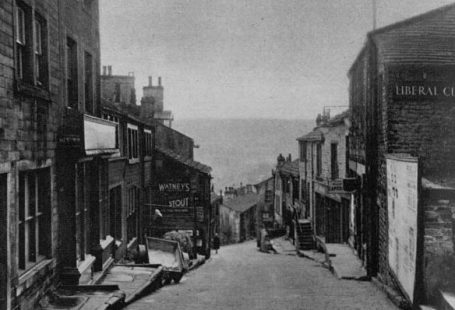This week at The Archive we are delighted to welcome 119,494 brand new pages, as well as the eight brand new titles which are joining us too, covering the commercial, military and agricultural interests of Britain in the first half of the nineteenth century.
We also have some exciting and comprehensive updates to ten of our existing titles this week, so read on to discover more about these, as well as our new titles of the week, and to find out about the murder of Lord William Russell in 1840, which attracted huge public interest.
Register now and explore the Archive
Somewhat unusually this week, we have published two newspapers with the same name – the London Mercury. And we start with the earlier incarnation of this title, the London Mercury 1828. This London Mercury was first published on 2 January 1828 by William Collier, consisting of four pages and appearing every Wednesday and Saturday.
It promised to contain ‘the two Gazettes, the Markets, and all other important Intelligence, which will be furnished for Fourteen-Pence.’ Moreover, the London Mercury 1828 claimed to be ‘the first Newspaper ever printed in London on this plan,’ i.e. appearing twice-weekly, which had ‘been for a long time a desideratum among those who are not disposed to incur the expense of a Daily Newspaper.’
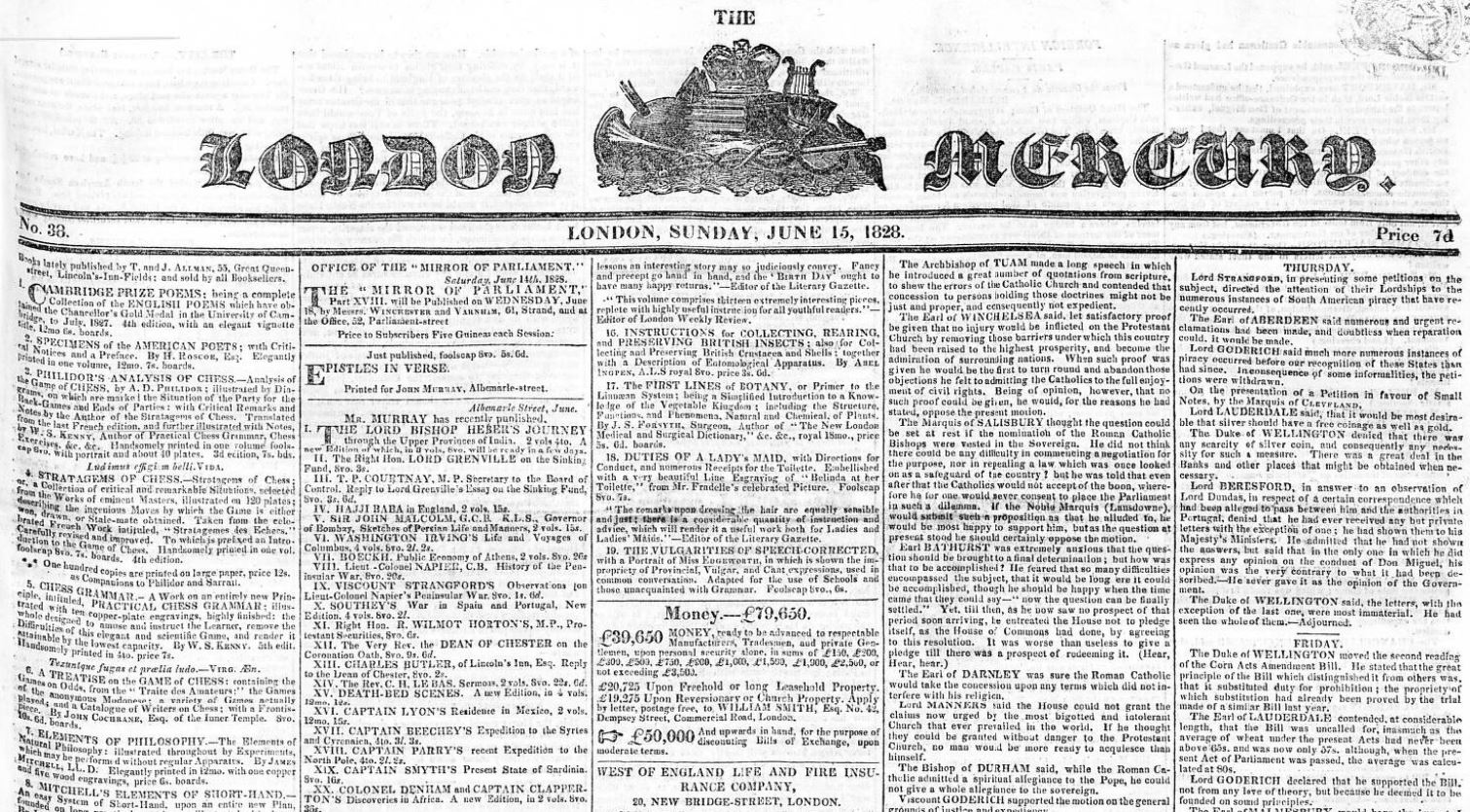
This bi-weekly summary of news contained, therefore, the latest from the ‘Foreign Papers’ as well as a section entitled ‘From Our City Correspondent.’ Other features centred on ‘The Chase’ – namely fox hunting – police news, recent executions, the latest from the debtors’ courts and notices of births, marriages and deaths.
Fast forward some twenty years and another London Mercury was being published in London, first appearing on 10 July 1847, consisting of eight pages and costing six pence. The London Mercury 1847 was published every Saturday, and described itself as a ‘New Weekly Free-Trade, Commercial and Family Newspaper, larger than the Times.’
This claim to size stemmed from the London Mercury 1847 being printed on a ‘Double Sheet, of the full size allowed by law,’ making it ‘one of the largest papers in the kingdom.’ Moreover, the London Mercury 1847 put across some other bold claims in its first edition, promising to be a ‘truthful and earnest representative of the common sense, the honesty, the general feeling, and the public spirit of the English people.’
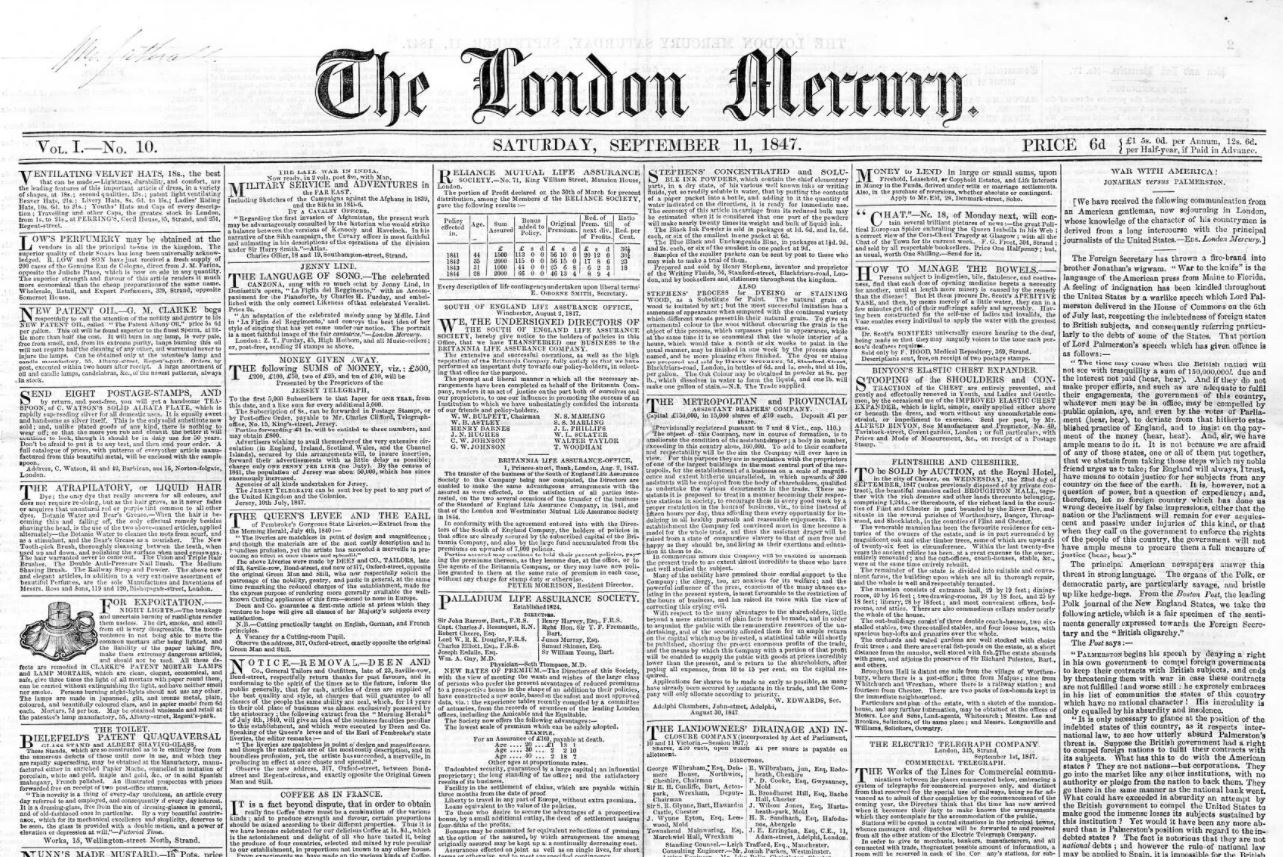
It pledged to use ‘much plainness of speech,’ being ‘desirous to convince than to dazzle, to be understood than to be admired.’ It would stand up to injustice, ‘uncompromisingly [opposing] every attempt against the Civil, Religious, and Commercial liberties of the people.’ But the London Mercury would not be extreme in its views. No, indeed, it would eschew ‘the violence of the ultra-Radical, the bigotry of the ultra-Protestant, [and] the folly of the the ultra Free-Trader.’
So what could you expect from the pages of the London Mercury 1847? It was filled with the usual political, foreign, legal and police intelligence, as well as an interesting recurring section entitled ‘Manufacturing Establishments of the Metropolis,’ which began with a look at the gas works at Vauxhall. The newspaper also contained sporting news, including a ‘Cricketers’ Register,’ a fashion column, a look at ‘Mortality in the Metropolis,’ which contained a breakdown of deaths and their causes in London, ‘Theatrical Chit Chat,’ and a column devoted to ‘Market and Commercial Intelligence.’
We have other new newspapers this week devoted to commercial matters, including the aptly named Commercial Chronicle (London). Consisting of four pages and appearing three times a week, the Commercial Chronicle cost seven pence and featured the latest news from the markets, as well as extracts from the French, Belgian and American papers. Within its pages you can also find ‘Sporting Intelligence,’ reports from the Old Bailey, and theatre news.
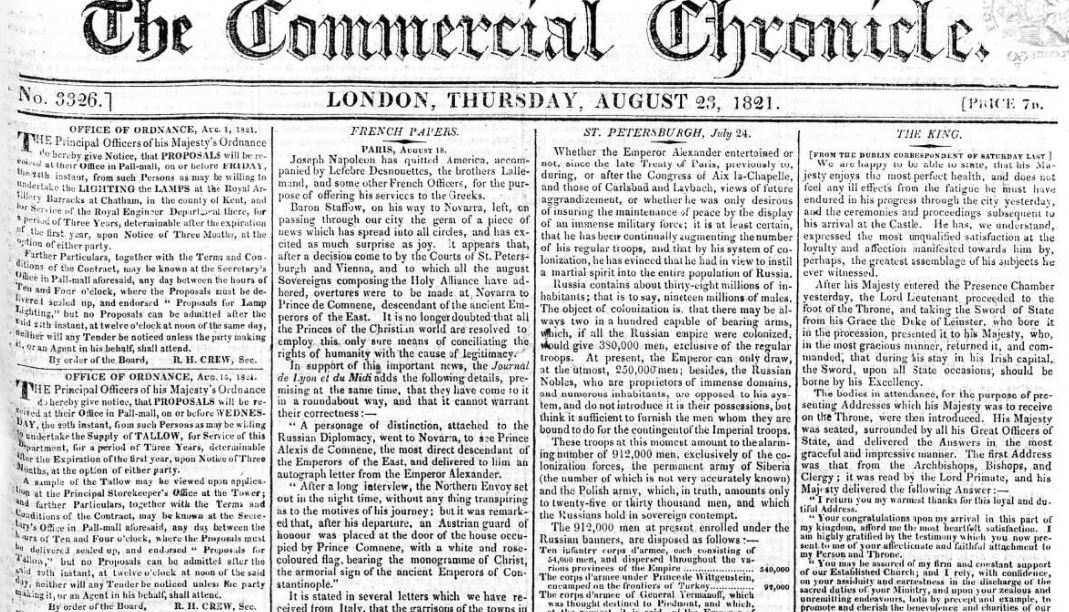
Another new newspaper this week devoted to commercial matters is the City Chronicle, which was published with the subheading of the ‘Tea Dealers’ Journal and Commercial Advertiser.’ First published on 12 May 1840 by David Morse, and appearing every Tuesday, the City Chronicle cost six pence.
Morse, in the newspaper’s first edition, gave the following introduction to the City Chronicle:
….as a commercial medium especially, I venture to anticipate that it will commend the attention of the TEA DEALER, TALLOW CHANDLER, CHEESEMONGER and HOP MERCHANT, who will find it an uncompromising advocate of their rights and privileges. I shall endeavour to make them FEEL they now have an ORGAN of THEIR OWN – one that will, in reality, and not in profession only, advance their interests, by protecting them from every species of imposition and tyranny.
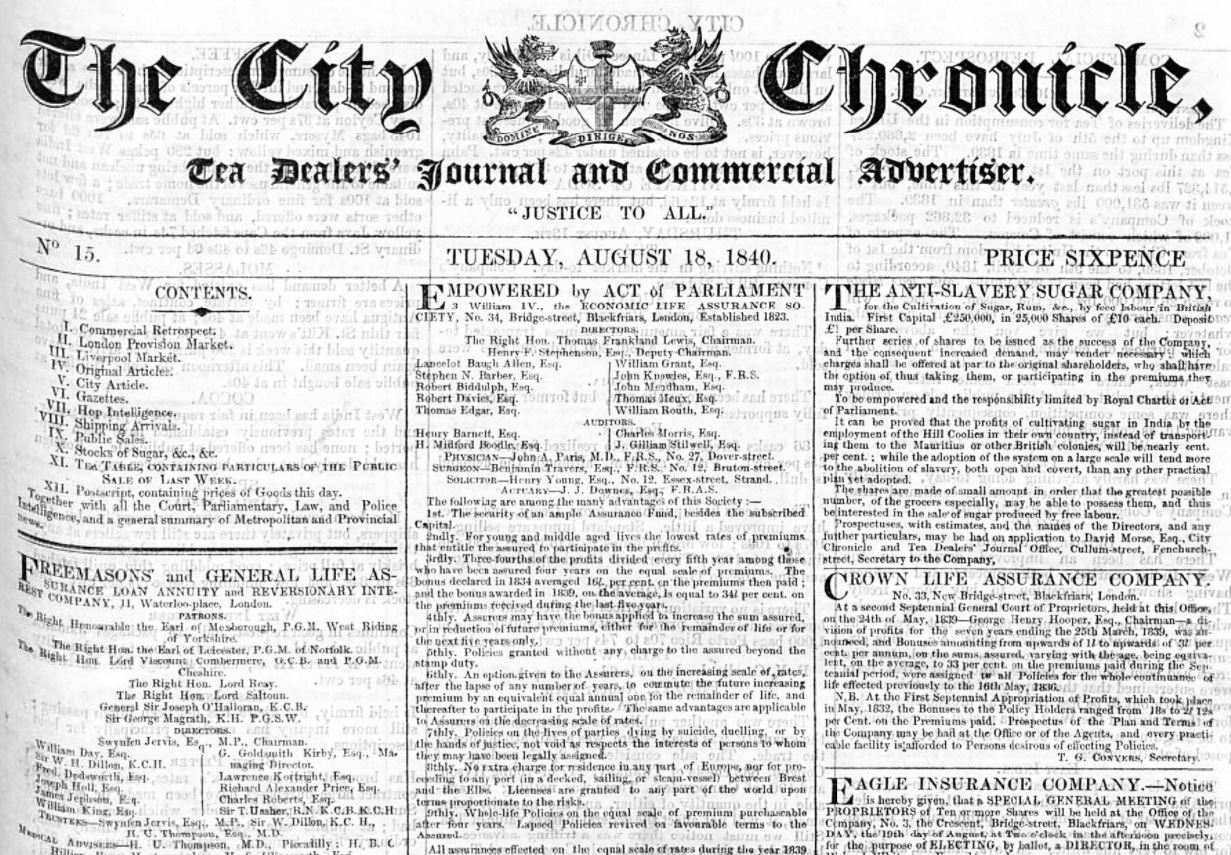
The City Chronicle, therefore, promised to represent a range of different trades, with an especial focus on the tea trade. Indeed, it contained such specialist articles as a ‘Cursory Review of the Tea Trade’ and ‘Agents – Their Use.’ But the City Chronicle certainly went beyond its stated remit; offering detailed reports on ‘Debates and Proceedings in Parliament,’ ‘Foreign and Colonial Intelligence,’ and ‘Provincial Intelligence.’
Meanwhile, the City Chronicle also wrote on sporting, law and police news, featuring a ‘Gazette of the Theatres,’ a look at ‘Military Exercises,’ ‘Liverpool Markets’ and finally the fashions of the month.
Rounding off our collection of commercial titles this week is Sainsbury’s Weekly Register and Advertising Journal. This intriguing title appeared every Saturday at the cost of two pence, its sole proprietor a Mr. Sainsbury, who was an ‘auctioneer, valuer and business agent.’ But what was the purpose of his Advertising Journal? An advert for the publication sheds a little more light on the matter:
‘I want to let my business’ – Then place the same in Sainsbury’s Weekly Register and Advertising Journal. It is the best medium in the whole world for Letting or Selling any kind of Business, either in town or country.
So, Sainsbury’s Weekly Register was basically a compendium of different adverts for businesses that were up for sale or were available to let. And the Weekly Register’s terms were ‘extremely moderate, for placing the business on the book, and advertisement in the Register till the business is let or sold.’ The newspaper, moreover, offered a circulation of 10,000 (with the anticipation of that doubling), also being ‘sent post free to all parts of the world.’
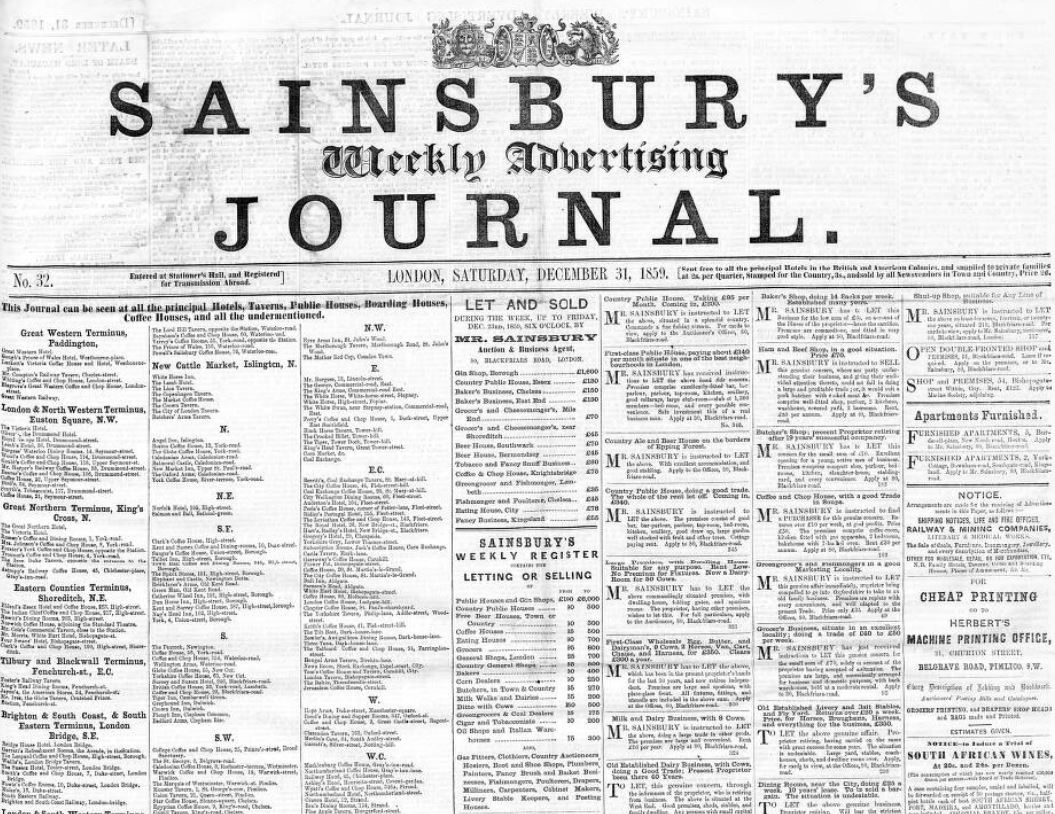
This circulation was extensive, as Sainsbury’s Weekly Register and Advertising Journal:
…could be seen every Saturday at the principle Hotels, Public Houses, Lodging and Coffee Houses, opposite the Railway Stations…and to be had of all Newsvendors and Railway Hotels in Town and Country.
The newspaper goes on to list every location where it was for sale. And further lists could be found within its pages, with descriptions of ‘Public Houses to Let in Town and Country.’ Sainsbury’s Weekly Register did not stop there, however, listing the grocers’, the cheesemongers’, the butchers,’ the stationers’, the cigar dealers’, the coal and dairy businesses all available to let or to sell.
Thus, Sainsbury’s Weekly Register offers a wonderful window onto the economic landscape of the ‘nation of shopkeepers,’ offering commentary also on topics of the week, the markets, theatres, money and commerce.
From Sainsbury’s now to Fleming’s, and Fleming’s British Farmers’ Chronicle. Starting life as Fleming’s Weekly Express, this was a special newspaper aimed at Britain’s agricultural community in the 1820s.
Indeed, an advert for Fleming’s British Farmers’ Chronicle ran as follows:
In consulting Fleming’s British Farmers’ Chronicle weekly, the Agricultural Community have the means of arriving at such accurate information of every description connected with Rural Affairs, from the highest authorities, as is not to be found in any other publication extant.
The ‘distinguishing features of this paper,’ according to the same advert, were its reports on ‘Cattle and Cheese Fairs’ and its ‘Monthly Agricultural Reports.’
Having perused the journals of Sainsbury and Fleming, we now take a look at our penultimate new title of the week – Thacker’s Overland News for India and the Colonies. Appearing from the 1850s onwards, Thacker’s Overland News for India and the Colonies consisted of an impressive 32 pages, costing six pence and was published by one Thomas Day. This newspaper was a ‘Weekly Summary of British and Foreign Intelligence,’ which appeared on the 3rd, 10th, 18th and 26th days of the month – ‘in time for dispatch via Marseilles.’
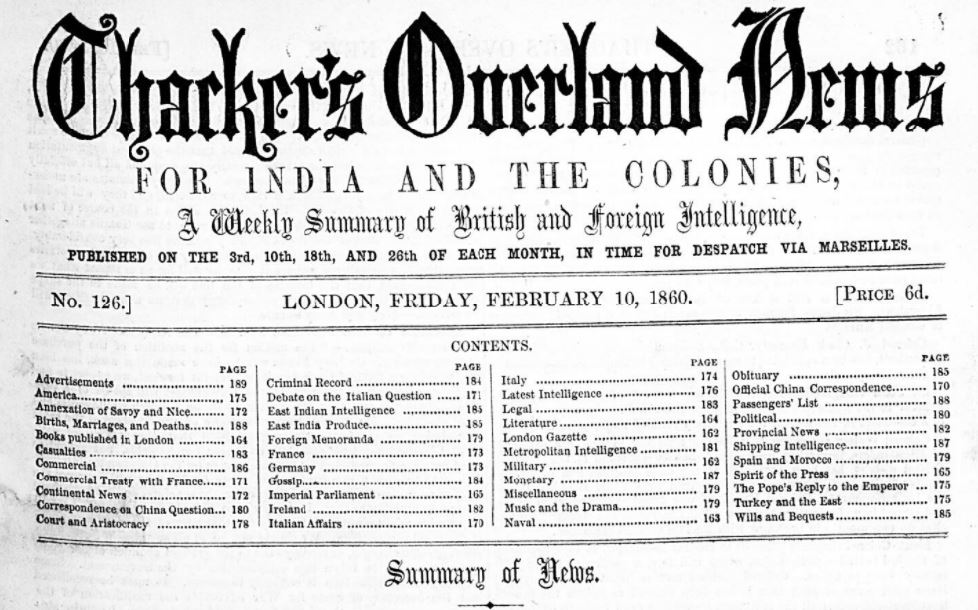
Packaging the home news for consumption by British people living in India, Thacker’s Overland News for India cost 16 rupees per annum and featured a thorough array of different subjects. Indeed, the newspaper even had a contents, listing the different subjects it covered, from Casualties to Court and Aristocracy, from Germany to Gossip, from East India Intelligence to Italy, from Legal to Literature, from Naval to Provincial, and from Obituaries to Shipping.
Our final new title of the week is another specialist one, joining our array of military titles that can be found on our Archive. We are, therefore, delighted to welcome the British Army Despatch to our collection, which was first published on 14 July 1848 at the cost of six pence. This newspaper’s full title was the slightly wordy British Army Despatch, Horse Guards, Ordnance and East India Company’s Military Service Record, and it promised that it was devoted exclusively to the:
…Interests of the Cavalry, Line, Royal Artillery, and Royal Engineers; Royal Marines; Medical and Commissariat Departments; the Militia; the Yeomanry; and the Honourable East India Company’s Military Service.
Indeed, the British Army Despatch’s first edition promised that it was an ‘officer’s paper,’ which would be a ‘firm advocate of the Service,’ whilst ‘truly [explaining] its views and interests, and at the same time [inspiring] a just feeling of loyalty and obedience in the soldiers’ breast.’
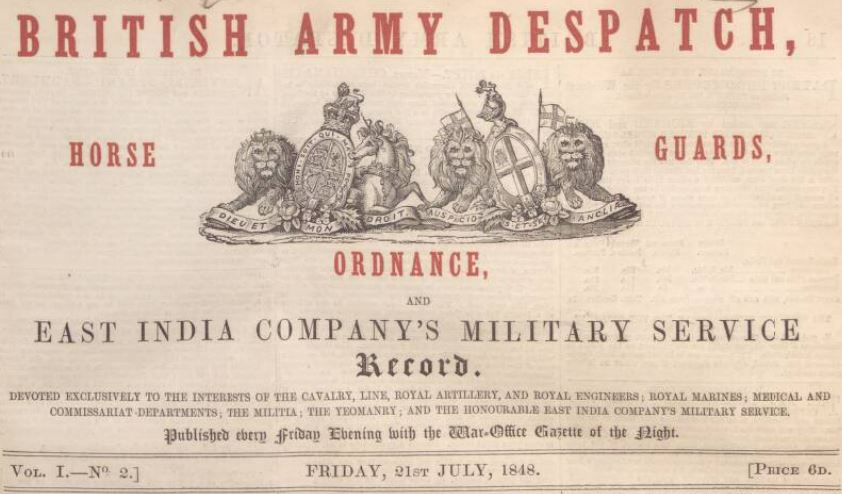
So what could you find within the pages of the British Army Despatch? With five of its sixteen pages devoted to a range of adverts, it included the latest ‘Regimental News’ from across the army, featuring a fascinating list of ‘Stations of Her Majesty’s Army.’ A treasure trove for those with military ancestors, this list features different regiments and their colonels, as well as their location at the time and their last country of service.
The British Army Despatch also featured other military related items, such as ‘Foreign Military Intelligence’ and a ‘Review of Military Works.’ Several pages of the publication were devoted to the East India Company, with more general interest columns devoted to literature and ‘theatricals.’
Appearing every Friday, in 1853 the British Army Despatch expanded to include the Royal Navy, becoming the British Army Despatch and Royal Naval Record, and then in 1854 becoming the British Army Despatch and Nautical Standard.
Alongside these exciting new titles, we have also made comprehensive updates to a range of our existing titles. For example, we have added over 87,000 pages to the Liverpool Journal of Commerce, and over 10,000 pages to the Bury Free Press, which span the 1980s. Meanwhile, we have added over one hundred years of headlines to both the Newmarket Journal and the Sheerness Times Guardian, covering thousands of pages from the 1880s through to the 1980s.
The Murder of Lord William Russell
On 6 May 1840 elderly politician Lord William Russell was found murdered in his bed, his throat apparently cut whilst he slept. In a case which shocked and fascinated the British public, it was his Swiss valet François Benjamin Courvoisier who was arrested for the crime.
Our new title the City Chronicle casts an intriguing light on what it dubbed the ‘mysterious and tragical event,’ illuminating the public interest in the crime, and how the case was eventually built against Courvoisier.
Lord William Russell’s body was discovered by his housemaid Sarah Mancer, and his valet, François Benjamin Courvoisier. Sarah Mancer had found the lower part of the household on Norfolk Street (now Durnaven Street, Mayfair) in disarray, and had feared a robbery, alerting Courvoisier before the two went to their master’s room.
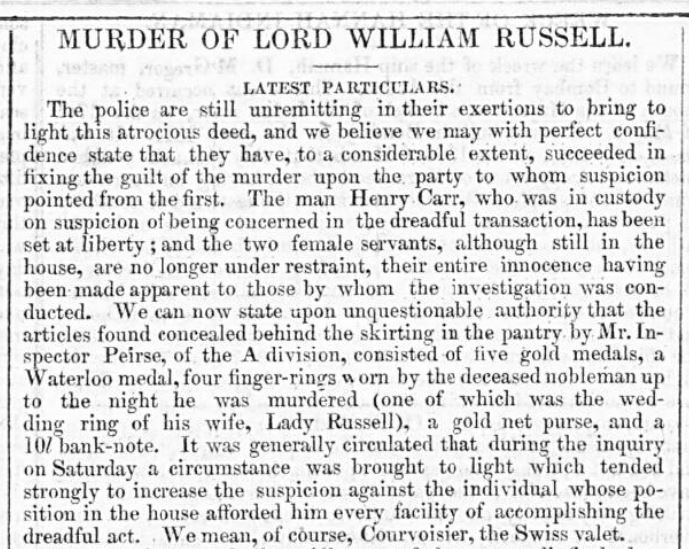
Nearly a week after the crime, the City Chronicle reports how:
This morning crowds from all parts of the metropolis flocked to Norfolk-street, with the double object of gratifying their curiosity by a sight of the house, and if possible to learn some further news respecting the dreadful affair.
Public attention in the case was at fever pitch, perhaps the combination of the murdered aristocrat and his foreign valet reading more like a romance rather than the usual crime fare reported on in newspapers of the time.
Meanwhile, the City Chronicle put its faith in the authorities, and their ability to bring Lord William Russell’s murderer to justice:
The police are still unremitting in their exertions to bring to light this atrocious dead, and we believe we may with perfect confidence state that they have, to a considerable extent, succeeded in fixing the guilt of the murder upon the party to whom suspicion pointed from the first.
But who was this party? The City Chronicle elaborates:
We can now state upon unquestionable authority that the articles found concealed behind the skirting in the pantry by Mr. Inspector Peirse, of the A division, consisted of five gold medals, a Waterloo medal, four finger-rings worn by the deceased nobleman up to the night he was murdered (one of which was the wedding ring of his wife, Lady Russell), a gold net purse, and an 10l bank-note. It was generally circulated that during the enquiry on Saturday a circumstance was brought to light which tended strongly to increase the suspicion against the individual whose position in the house afforded him every facility of accomplishing the dreadful act. We mean, of course, Courvoisier, the Swiss valet.
The discovery of stolen items, stashed away in the pantry, pointed a finger at Courvoisier and structured the case against him. He had stolen from his master, his master had found out, and Courvoisier had killed him rather than let the truth be known. This was despite Courvoisier having no blood on his clothes; although it was theorised that he had committed the murder in a state of undress.
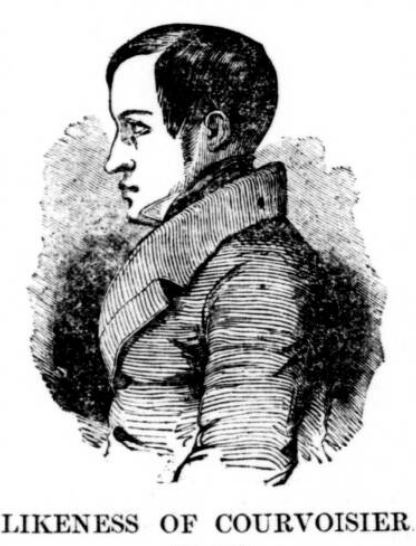
Meanwhile, the City Chronicle had another reason for suspecting Courvoisier of the crime, namely his behaviour:
It is stated that when the police first entered the house and proceeded up to the room in which the murderous transaction occurred, they requested Courvoisier to assist them in lifting up the body, that they might search the bed for the purpose of discovering the instrument with which the horrid deed was committed; he instantly shrank back, and, shuddering, said he could not touch it. He has, we understand, been exceedingly taciturn through the day, and has at times occupied himself with reading, and at other times perambulating the room in which he is contained.
Courvoisier was eventually charged with the crime, and sent to Newgate, but public attention towards the case showed no signs of waning. Indeed, the City Chronicle reports over a month later on 9 June 1840 how ‘The interest evinced among all classes by the above mysterious and tragical event has not in the slightest degree been diminished.’
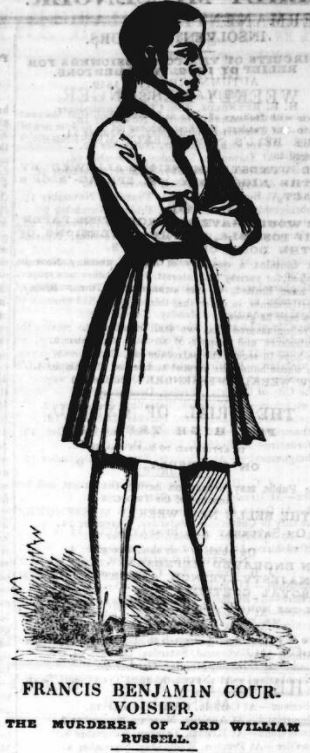
Armchair sleuths, then as now, were in abundance, the City Chronicle detailing how:
Daily during the past week have groups of persons assembled in front of the house in Norfolk-street, anxiously discussing the points of evidence bearing against the accused; and numerous letters, offering suggestions, tending, in the opinion of the writers, to the probability of adding a link to the chain of circumstantial evidence with which the public are already acquainted, still continue to be received by the police.
Crowds were still being drawn to the scene of the crime, and crowds would follow Courvoisier to his trial. The City Chronicle, in chilling detail, describes the moment when the verdict was read:
After the jury had been absent for an hour and twenty-five minutes, they returned to the court, and the prisoner was again placed at the bar.
The Foreman of the Jury, in a low voice, said ‘We find him GUILTY!’
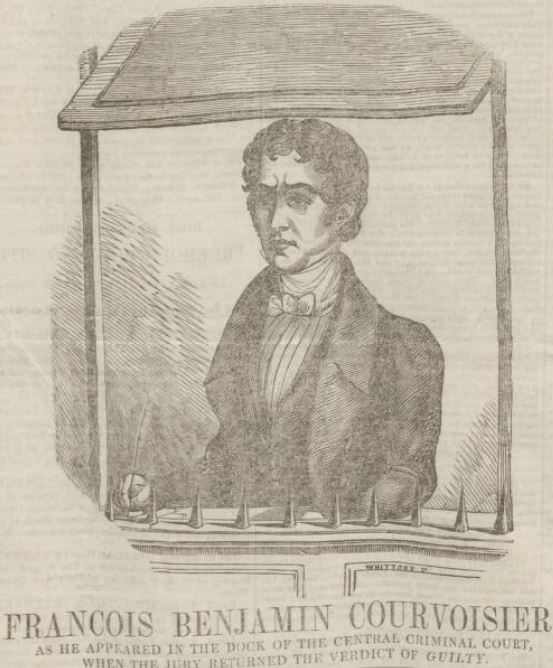
The Clerk of the Court then said: Francois Benjamin Courvoisier, you have been found Guilty of the wilful murder of William Russell, Esq., commonly called Lord William Russell; what have you to say why the Court should not give you sentence to die according to law?
The prisoner made no reply. The usual proclamation for silence was then made. Lord Chief Justice Tindal then passed sentence of death upon the prisoner in the usual form. The learned Judge, in delivering the sentence, was so affected that his voice at times was scarcely audible. The prisoner heard his fate pronounced without the slightest emotion.
As a kind of after note, the paper adds how ‘The court was very much crowded to the last.’
And the crowds followed François Benjamin Courvoisier to his execution, which took place on 6 July 1840. 40,000 people, including novelists Charles Dickens and William Makepeace Thackery, witnessed the execution of the 23-year-old. Both writers opposed the death penalty. Meanwhile, in 2017 Courvoisier’s death mask was put up for auction, and sold for £20,000.
New Titles
Title |
Years Added |
| British Army Despatch | 1848-1856 |
| City Chronicle | 1840-1843 |
| Commercial Chronicle (London) | 1816, 1819-1822 |
| Fleming’s British Farmers’ Chronicle | 1864 |
| London Mercury 1828 | 1828 |
| London Mercury 1847 | 1847-1848 |
| Sainsbury’s Weekly Register and Advertising Journal | 1859-1863 |
| Thacker’s Overland News for India and the Colonies | 1860-1863 |
Updated Titles
This week we have updated ten of our existing titles.
You can learn more about each of the titles we add to every week by clicking on their names. On each paper’s title page, you can read a FREE sample issue, learn more about our current holdings, and our plans for digitisation.
Title |
Years Added |
| Brief | 1879 |
| Bury Free Press | 1982-1984, 1986 |
| Glasgow Courier | 1848 |
| Liverpool Journal of Commerce | 1870, 1882, 1911-1917, 1921-1927, 1929, 1931-1939 |
| Newmarket Journal | 1882-1896, 1898-1911, 1913-1917, 1982-1984 |
| Pilot (London) | 1815 |
| Press (London) | 1861-1866 |
| Sheerness Times Guardian | 1885, 1887, 1895, 1897, 1899-1900, 1902-1910, 1912-1915, 1922-1939, 1981, 1987 |
| Weekly Times (London) | 1830-1831 |
| Widnes Examiner | 1917 |
You can keep up to date with all the latest additions by visiting the recently added page. You can even look ahead to see what we’re going to add tomorrow.





